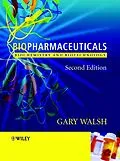The latest edition of this highly acclaimed textbook, provides a comprehensive and up-to-date overview of the science and medical applications of biopharmaceutical products. Biopharmaceuticals refers to pharmaceutical substances derived from biological sources, and increasingly, it is synonymous with 'newer' pharmaceutical substances derived from genetic engineering or hybridoma technology. This superbly written review of the important areas of investigation in the field, covers drug production, plus the biochemical and molecular mechanisms of action together with the biotechnology of major biopharmaceutical types on the market or currently under development. There is also additional material reflecting both the technical advances in the area and detailed information on key topics such as the influence of genomics on drug discovery.
Autorentext
Gary Walsh is a senior lecturer in industrial biochemistry at the University of Limerick, Ireland. He combines industrial experience within the pharmaceutical industry with an extensive teaching and academic research background in pharmaceutical biotechnology. He has published half a dozen highly acclaimed books on various aspects of protein biotechnology. He is on the editorial board of several biopharmaceutical journals and is closely affiliated with the European Association of Pharma Biotechnology, serving as its scientific secretary.
Klappentext
Biopharmaceuticals: Biochemistry and Biotechnology, Second Edition, provides a comprehensive, up-to-date overview of the science and medical applications of biopharmaceutical products.
Extensively revised and updated, the Second Edition of this highly successful textbook discusses the latest developments in the field, providing a greater focus on actual commercial products and how they are manufactured. Substantial new sections on detailing biopharmaceutical drug delivery and how advances in genomics and proteomics will impact upon (bio)pharmaceutical drug development are also included.
- Provides a balanced overview of the biopharmaceutical industry, including material on key developments in the field.
- Each chapter supplemented with an extensive further reading section
- Aimed at students taking courses in biotechnology, pharmaceutical science, biochemistry, microbiology or medicine
- An ideal reference for those already employed in the (bio)pharmaceutical sector wishing to gain a better overview of the industry.
Reviews of Biopharmace u ticals:
"Biopharmaceuticals: Biochemistry and Biotechnology contain(s) some very useful information and ultimately serves as a comprehensive introduction to both the biopharmaceutical industry and its role within the larger arena of pharmaceuticals. For those new to, or keen to be involved with biopharmaceuticals, the book will undoubtedly provide a solid grounding of not just the technology, but of the industry as a whole."
Pharmaceutical Technology Europe
"This great compliment of scientific literature, is easy-to-read and understand, up-to-date as well as comprehensive."
Bioseparation
"Biopharmaceuticalsis well written and provides an excellent overview of the biotechnology industry. This book is an excellent and balanced source of information about the biotechnology industry."
FEBS Letters
Inhalt
Preface xvii
Chapter 1 Pharmaceuticals, biologics and biopharmaceuticals 1
Introduction to pharmaceutical products 1
Biopharmaceuticals and pharmaceutical biotechnology 1
History of the pharmaceutical industry 3
The age of biopharmaceuticals 5
Biopharmaceuticals: current status and future prospects 8
Traditional pharmaceuticals of biological origin 12
Pharmaceuticals of animal origin 13
The sex hormones 14
The androgens 14
Oestrogens 15
Progesterone and progestogens 17
Corticosteroids 19
Catecholamines 21
Prostaglandins 23
Pharmaceutical substances of plant origin 27
Alkaloids 28
Atropine and scopalamine 28
Morphine and cocaine 29
Additional plant alkaloids 30
Ergot alkaloids 30
Flavonoids, xanthines and terpenoids 30
Cardiac glycosides and coumarins 33
Aspirin 33
Pharmaceutical substances of microbial origin 33
The macrolides and ansamycins 38
Peptide and other antibiotics 39
Conclusion 39
Further reading 40
Chapter 2 The drug development process 43
Drug discovery 44
The impact of genomics and related technologies upon drug discovery 45
Gene chips 47
Proteomics 49
Structural genomics 50
Pharmacogenetics 51
Plants as a source of drugs 52
Microbial drugs 53
Rational drug design 54
Combinatorial approaches to drug discovery 56
Initial product characterization 57
Patenting 57
What is a patent and what is patentable? 57
Patent types 62
The patent application 63
Patenting in biotechnology 64
Delivery of biopharmaceuticals 66
Oral delivery systems 66
Pulmonary delivery 67
Nasal, transmucosal and transdermal delivery systems 68
Pre-clinical trials 69
Pharmacokinetics and pharmacodynamics 69
Toxicity studies 71
Reproductive toxicity and teratogenicity 71
Mutagenicity, carcinogenicity and other tests 72
Clinical trials 73
Clinical trial design 75
Trial size and study population 75
Randomized control studies 76
Additional trial designs 76
The role and remit of regulatory authorities 78
The Food and Drug Administration 78
The investigational new drug application 80
The new drug application 82
European regulations 84
National regulatory authorities 84
The EMEA and the new EU drug approval systems 85
The centralized procedure 86
Mutual recognition 88
Drug registration in Japan 88
World harmonization of drug approvals 89
Conclusion 89
Further reading 89
Chapter 3 The drug manufacturing process 93
International pharmacopoeia 93
Martindale, the Extra Pharmacopoeia 94
Guides to good manufacturing practice 94
The manufacturing facility 97
Clean rooms 98
Cleaning, decontamination and sanitation (CDS) 101
CDS of the general manufacturing area 102
CDS of process equipment 102
Water for biopharmaceutical processing 104
Generation of purified water and water for injections (WFI) 105
Distribution system for WFI 107
Documentation 109
Specifications 110
Manufacturing formulae, processing and packaging instructions 110
Records 111
Generation of manufacturing records 111
Sources of biopharmaceuticals 112
E. coli as a source of recombinant, therapeutic proteins 112
Expression of recombinant proteins in animal cell culture systems 116
Additional production systems: yeasts 116
Fungal production systems 117
Transgenic animals 118
Transgenic plants 122
Insect cell-based systems 123
Production of final product 124
Cell banking systems 127
Upstream processing 128
Microbial cell fermentation 129
Mammalian cell culture systems 133
Downstream processing 134
Final product formulation 140
Some influences that can alter the biological activity of proteins 142
Proteolytic degradation 143
Protein deamidation 144
Oxidation and disulphide exchange 145
Alteration of glycoprotein glycosylation patterns 147
Stabilizing excipients used in final product formulations 150<…
